

|
Dead at 43 Sam Deich, my
maternal grandfather, died at the age of 43 because of "a virus infection in
his head," according to his older daughter, Mollie. Today such an ailment would be
remedied by antibiotics, which had not yet been discovered in 1930. Sam was born in 1887, which made him seven years younger than Morris Rubenstein (the father of Larry Rogers, his son-in-law). |
![]()
| Expert dress cutter Sam
worked as a dress cutter of "very, very good dresses," Mollie said. Sam and
Fannie were introduced by her brother, Sol. Sol and Fannie had made the voyage
together to America from Lida, Vilna goberniya. (Sol went into the fur business and
later moved to Pottstown, Pennsylvania. He died young, in an automobile accident on
the way to an evening meeting at his shul, Mollie said.)
Garment center seamstress Fannie found work in the garment center as a seamstress, but after her marriage to Sam, she never returned to work outside the home. Fannie and Sam were living on Bergen Street in Brooklyn at the time he became ill. Mollie had moved out the year before, following her marriage to Phil Epstein. After Sam's death, Tess went to live with Mollie and Phil and stayed there until her marriage to Larry Rogers in 1938. |
![]()
| Birthdate
unknown We don't know Sam Deich's birthday; his tombstone says only that he died
on December 7, 1930 at the age of 43. Mollie was born in 1910, when Sam was 23 and Fannie was 22. Tess was born in 1915, when Sam was 28 and Fannie was 27. 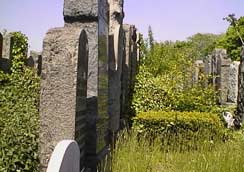 Row H in the Workmen's Circle; Sam is the eighth plot down, from left to right. |
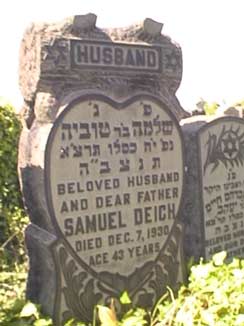 |
![]()
| Tree trunk stone Sam's
stone is tall and dark, simulating the look of a tree trunk., which appears to have been
the prevailing 1930's fashion, judging by the stones around him. A horizontal log with two
branches sawed off is carved across the top. The dark lettering on a light background
appears as clear as it must have been when it was new, 69 years ago. Leaves and ferns are
carved around an area vaguely shaped like a heart, along with a Hebrew inscription and the
English words, "Beloved husband and dear father, Samuel Deich." A plot opened up Everyone in the row was buried in 1930 with the exception of Sam's wife, Fannie, who is eight plots from him. How did it happen that a place was found for her in 1961? "We got a phone call from the cemetery telling us that a plot in that row had become available," Mollie said. "The family of a young boy buried there had just moved him to a new family plot they acquired." |
![]()
 Fannie Pollack Deich was born in 1888, which makes her one year younger than her husband (and two years younger than Morris' wife, Esther Simon Rubenstein.) |
Gall bladder
cancer We don't know Fannie's birthday, either. She died on July 28, 1961, at the
age of 73. She had been suffering from cancer of the gall bladder, Mollie said. After
Fannie became ill, she moved to Second St. in the Gravesend section of Brooklyn to live
with Mollie and Phil. 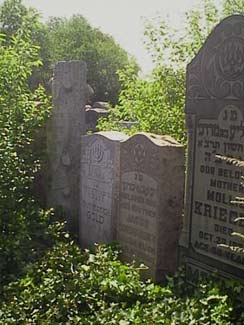 |
![]()
| Rosebud incised Fannie's
stone is light grey with incised carving in contrast to the raised style of the lettering
on Sam's stone. A branch from a rose bush with one bud and one blossom frames a candelabra
carved over a Hebrew inscription and the words, "Fannie Deich Gold, died July 28,
1961, age 73 years, Dear Grandmother." Fannie had remarried; a widower, Benjamin
Gold, lived in her building, and the couple wed about a year after Sam's death, Mollie
said. Life span increase Fannie is buried between a woman who died at 45 years of age, and a boy who died at 21. Sam is buried between a man who died at 52 and another who died at 45. The increase in life span is striking. |
![]()
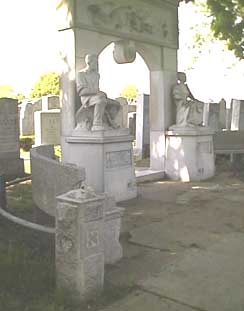 |
Both Fannie and Sam
are buried at Mt. Lebanon Cemetery in Queens in an area devoted to members of the Workmen's
Circle. It was a politically oriented fraternal organization founded "as a
mutual aid society in 1892, and reorganized as a national order in 1900," according
to Jewish Immigrant Associations and American Identity in New York, 1880-1939
by Daniel Soyer. Immigrant societies arranged burials The Workmen's Circle provided a way "to serve the immediate material needs of the immigrant members," and an important part of this was burial. |
| On the Rubenstein side of the family, this
need was filled by the Gorodok landsmanshaftn, which are associations of
people from the same town. A long list of Rubensteins are at rest in their plots in
various cemeteries. Click here for our "Cemetery Summary" page. Family activity in landsmanshaftn Morris' brother-in-law, Carl Karben, was an active member, and Carl's daughter, Shirley, remembered he attended meetings regularly. The societies also held fancy dress balls, not every year, but perhaps every five years, according to Marcy Patashnick, a daughter of Morris' sister, Esther-Minnie. She remembered traveling down to the city from the family home in North Adams, Massachusetts, for one such ball; she also remembered the special blue dress she got just for that occasion. Meetings, balls, and dinners, too. Eli Schwartz, whose great grandmother was a first cousin of Morris' father, remembers attending a fancy dinner for which a special program was printed. When he locates his copy, a reproduction of its cover will find its way into the section on Toby's branch, into either the story about her husband, Aaron Kahanovich (click here), or the story about her oldest son-in-law (click here). Rafael Millerkowski was an organizer of one of the Gorodok landsmanschaftn (there were several). Their first objective was to bring to America the rest of their family members, and after that, the focus turned to providing the services that immigrant families required. By 1917, the Workmen's Circle counted 25,000 New Yorkers as members , including those of 143 landsmanshaftn. The orientation of the Workmen's Circle was political -- radical, to be specific -- rather than geographic, Soyer said.Workmen's Circle dominates cemetery The Workmen's Circle has two very large sections on opposite ends of the Mt. Lebanon Cemetery in Queens, off Myrtle Avenue with entrances at 73rd and 78th Streets. Sam and Fannie are in Section H, which is easily found. From there on, you're on your own. There are no further directions; "row 12, plots 12 and 20" are impossible to find. After a 30-minute wait for the foreman to appear on his periodic rounds of supervising the grounds staff in the area, he guided me straight to the spot.
Row 12 is not reached by counting from the road. Instead one is to walk on the H path a long distance until seeing a "10" painted on the sidewalk. Then one turns around and proceeds two rows forward, reaching row 12. Grounds foreman saves the day Plots 12 and 20 are
not reached by counting outwards from the road to the inside as I had done. The system,
once at row 12, reached as per the above, is to count from the path outward. And there is
no hint as to whether one should count from the left or the right. Tommy, the grounds
staff foreman, knew to turn right, and found Fannie at plot 12, and 8 plots beyond Fannie,
there was Sam. |
|
Fanny's family tree - The File For Poliaczek cousins - descendants of
Fanny's siblings - who want to build their own trees on the Poliaczek trunk,
there is our GEDOM file (genealogical data
communication) to kickstart such an endeavor. Corrections and additions welcome: smrogers@cousinsplus.com. |
|
|
|
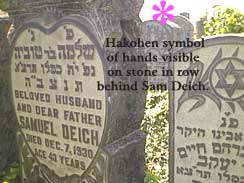 Click here for story on HaCohenim and HaLevim in our family. |
![]()